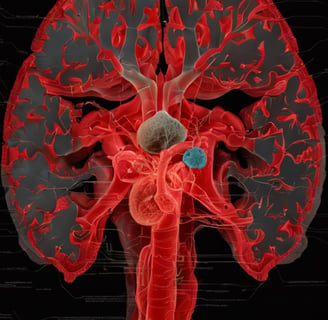The Amygdala: From Fear to Freedom
In this article you will learn about the part of the brain that processes fear, and how you can use this knowledge to reduce your fears.
3 min read
What is it?
What is the Amygdala?
The amygdala, a small but powerful structure nestled deep within the brain's temporal lobes, is often considered the emotional epicenter of our minds. Derived from the Greek word "amygdale," meaning almond, its name reflects its almond-like shape. Within this unassuming structure lies a world of intricate emotions, primarily centered around the emotion of fear.
Amygdala's Role in Fear
Low activity in the amygdala is associated with a reduced fear response. In contrast, when the amygdala is hyperactive, it can lead to heightened anxiety and even panic. This duality sets the stage for exploring how to modulate its activity and tame the fear within us.
Stress and the Amygdala
When stress levels escalate, the amygdala becomes hyperactive, contributing to increased feelings of anxiety and fear. This heightened alertness can drain our energy and disrupt our overall well-being. Understanding this connection is pivotal in our quest to conquer fear.
Aggression and Fear
Another intriguing aspect of high amygdala activity is its link to increased aggression. Overstimulation of the amygdala can make individuals more prone to anger and hostility. By learning to regulate amygdala activity, we can also gain mastery over our aggressive tendencies and respond to challenging situations with greater composure.
Threat Detection
The amygdala plays the role of a vigilant sentinel, ceaselessly scanning our environment for potential threats. When it detects danger, it initiates the "fight or flight" response, alerting other brain regions and bodily systems to prepare for action.
Processing Negative Emotions
The amygdala helps process various negative emotions, including sadness and disgust.
Stress Signals and Hormonal Response
The amygdala is a communication hub, sending stress signals to the hypothalamus. This, in turn, activates the body's autonomic nervous system and endocrine system. The result? Physical symptoms, such as increased heart rate, elevated blood pressure, and the release of stress hormones, underscore the amygdala's central role in our stress response.
Balancing Emotions and Pleasure
Surprisingly, the amygdala is not solely responsible for negative emotions. It also contributes to the experience of pleasure and reward. Understanding its role in positive and negative emotional experiences allows us to strive for a balanced emotional life.
Memory Formation and Assessment
The amygdala forms and consolidates fear-related memories. This function empowers us to learn from past experiences and avoid potential threats in the future. Additionally, the amygdala assesses the emotional significance of memories, influencing the intensity of our emotional responses when recalling them.
How can I use this info?
Reducing Amygdala Activity and Finding Freedom from Fear
Now that we've uncovered the profound role of the amygdala in fear and emotional responses let's explore strategies to reduce high activity in the amygdala and live a life with less fear.
Embracing Mindfulness
Techniques like meditation and deep breathing exercises have demonstrated their effectiveness in calming the overactivity of the amygdala. We can diminish our fear responses and regain emotional equilibrium by grounding ourselves in the present moment and training our minds to release excessive worry.
Controlled Exposure
By gradually desensitizing our amygdala through measured exposure, we can reshape our emotional responses and become less susceptible to fear. This method allows us to confront and conquer our anxieties head-on.
Stress Management
Stress-reduction techniques such as exercise, relaxation, and a healthy lifestyle can help keep the amygdala's hyperactivity in check.
Seeking Balance
Cultivating positive emotions through activities that bring joy, fulfillment, and contentment can counteract the amygdala's tendency to amplify fear and stress.
Harnessing Memory
We can harness the amygdala's role in memory formation to reduce fear. By revisiting past experiences in a controlled and supportive environment, we can rewrite our fear-related memories, gradually diminishing their emotional intensity.
I am comfortable with dangerous situations. It's not my cup of tea to be in one, but I calmly answer when something fear-inducing knocks at my door. I had no idea why things never scared me. I am a thrill seeker, and I love going on adventures. I can proudly say that fear does not stop me from doing anything, and that helps me live without regrets.
I did not think anything about it or even notice until my friends and family around me constantly warned me of things and were cautious of me because of my recklessness.
There is a drawback to being "fearless"; since my brain doesn't alert me that certain things are threatening, I fail to assess that I am in a dangerous situation. My family and friends have saved me from potential accidents on numerous occasions. It's to the point that they are not surprised anymore, and it has become normal. If it weren't for them, I would not even be alive.
I used to be highly fearful as a child. Since I have not resonated with the emotions of fear for around a decade, I have lost my ability to comprehend it. There have been countless times when someone shares that they want to do something for themselves but are "too scared to." I sympathize with and hear them out, but I cannot comprehend how fear can stop someone.
Seeing how much fear can hinder someone's ultimate happiness is saddening, so I want to talk about it.


